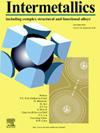Electrodeposition and properties of Ni-Co-W-(Mo-Cu) high/medium entropy alloy coatings deposited from an aqueous bath
IF 4.3
2区 材料科学
Q2 CHEMISTRY, PHYSICAL
引用次数: 0
Abstract
This study aimed to deposit multi-elemental coatings, including Ni-Co-Mo-W, Ni-Co-Cu-W and Ni-Co-Cu-Mo-W, with different configurational entropy from an aqueous bath by direct current electrodeposition. For this purpose, the effect of current density on the elemental composition was studied, and it was shown that the induced deposition of W was mainly controlled by Co, while the induced deposition of Mo was affected by both Ni and Co. In addition, Ni showed an activation deposition mechanism, while Mo suffered from concentration polarization for a prolonged electrodeposition process. All elements deposited homogeneously through the coatings' thickness except Cu showed some segregation. However, XRD spectra proved to have an amorphous structure for all coatings. Upon heat treatment, the crystallization of the coatings occurs, which results in an increase in hardness values from 5.6 to 11 GPa by increasing the heat treatment temperature up to 800 °C in the case of Ni-Co-Mo-W coating. The maximum hardness values were achieved at 500 °C in other coatings, and then a slight decrease was observed. Polarization results of the as-deposited coatings showed the potential for passivation of these coatings. However, due to the defects in the coatings, they were not completely protective towards the substrate. The results suggest that the presence of Cu had the main impact on the coating's properties since it decreased Co deposition, the hardness and the thermal stability of the coatings.
Ni-Co-W-(Mo-Cu)高/中熵合金涂层的电沉积及性能
本研究旨在通过直流电沉积方法在水溶液中沉积不同构型熵的Ni-Co-Mo-W、Ni-Co-Cu-W和Ni-Co-Cu-Mo-W等多元素镀层。为此,研究了电流密度对元素组成的影响,结果表明:W的诱导沉积主要受Co的控制,而Mo的诱导沉积则受Ni和Co的共同影响。此外,Ni表现为活化沉积机制,而Mo在长时间电沉积过程中受到浓度极化的影响。除Cu外,其余元素在涂层中均呈均匀沉积。然而,XRD光谱证明了所有涂层都具有非晶结构。热处理后,涂层发生结晶,将Ni-Co-Mo-W涂层的热处理温度提高到800℃,硬度值从5.6增加到11 GPa。其他涂层的硬度值在500℃时达到最大值,然后略有下降。镀层的极化结果表明,镀层具有钝化的潜力。然而,由于涂层本身的缺陷,涂层不能完全保护基体。结果表明,Cu的存在降低了镀层的Co沉积,降低了镀层的硬度和热稳定性,是影响镀层性能的主要因素。
本文章由计算机程序翻译,如有差异,请以英文原文为准。
求助全文
约1分钟内获得全文
求助全文
来源期刊

Intermetallics
工程技术-材料科学:综合
CiteScore
7.80
自引率
9.10%
发文量
291
审稿时长
37 days
期刊介绍:
This journal is a platform for publishing innovative research and overviews for advancing our understanding of the structure, property, and functionality of complex metallic alloys, including intermetallics, metallic glasses, and high entropy alloys.
The journal reports the science and engineering of metallic materials in the following aspects:
Theories and experiments which address the relationship between property and structure in all length scales.
Physical modeling and numerical simulations which provide a comprehensive understanding of experimental observations.
Stimulated methodologies to characterize the structure and chemistry of materials that correlate the properties.
Technological applications resulting from the understanding of property-structure relationship in materials.
Novel and cutting-edge results warranting rapid communication.
The journal also publishes special issues on selected topics and overviews by invitation only.
 求助内容:
求助内容: 应助结果提醒方式:
应助结果提醒方式:


